Managed Intensive Rotational Grazing. That’s a mouthful. MIRG for short.
MIRG is a system of pasturing animals to maximize pasture growth. Proponents call it farming grass.
Rotational grazing is nothing new. Dividing up a pasture into paddocks to prevent overgrazing goes back to the earliest agrarian societies. What is fairly recent is intensive rotational grazing. Instead of pasturing animals in a large paddock for a month or two, then moving them to the next paddock, MIRG is pasturing animals in very small paddocks for just a few days at a time, or in some cases hours.
The heart of the idea stems from giving pasture the optimum amount of time to re-grow before being grazed again. Short grazing periods stimulate growth, long grazing periods destroy pasture.
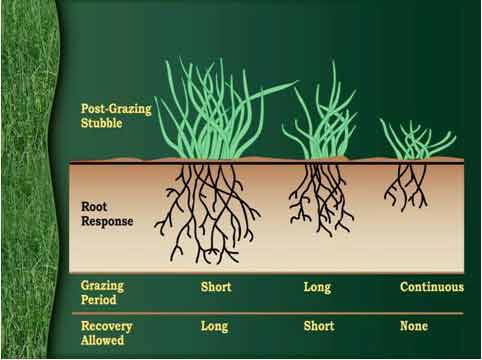
There are many benefits to the animals as well:
- Animals are exposed to more varieties of forage because they cannot simply return to their favorite alfalfa patch every day
- Animals are forced to move and exercise more
- Fewer parasites build up in the soil and affect the animals
- Manure is more evenly spread
Finally, perhaps the biggest benefit of all is soil health. MIRG and techniques like it build up far larger amounts of topsoil than any other known method. Rather than continually depleting the soil and subsidizing with chemical fertilizers, MIRG allows me to build healthier pastures that are self-sustaining.
Contrary to what it may seem, grazing is necessary to healthy pastures. If pastures are not grazed they turn into deserts. This was brought to my attention by the compelling TED talk by Allan Savory, a pioneer in the field of holistic land management.
Since acquiring our sheep last Summer I have had this nagging desire to figure out MIRG and apply it to our farm.
Tonight, I finally figured it out.
My first question was, can MIRG be used with a small scale of animals? We have 3 ewes and 1 ram currently, expecting lambs this Spring. The answer appears to be yes; I have found no literature saying there is a minimum amount of animals required. As long as the space requirements are met, the benefits of rotational grazing applies to 4 sheep just as much as 40,000.
My second question was, how do I size the paddocks for the number of sheep I have? The numbers are all over the map on this, and “stocking density” isn’t a terribly popular subject online. Thanks to a University of Minnesota Extension presentation, I was able to get some hard numbers and convert them for our farm.
The calculations use “Animal Units” or AU’s which are a livestock standard based on a mature 1,000 pound cow. The MIRG approach assumes 33 AUs per acre per day. So that’s 33 cows, or about 33,000 pounds. Keep in mind, this is dependent on the pasture productivity. It could be as low as 25 AUs or high as 80 AUs. But for the purposes of getting started, I am going with the 33 AU number.
My last question was, how big do I need to make the paddocks and how many of them do I need? If MIRG requires 33 cows per acre, that equates to 1,320 square feet per cow. Since our mature sheep are approximately 200 lbs, they will need 1/5th the space, or 264 sq ft.
The grazing periods should be as frequent as you can handle, no more than 5 days per paddock. Once per day seems to be a desirable number in most of the literature. But I have a day job, so I’m settling for twice per week. That means I will increase the spacing by 3.5, which is ~900 sq ft per sheep. Multiply by 4 sheep and we get to 3,600 square feet per paddock.
Square paddocks are recommended as opposed to rectangular or wedge-shaped which do not tend to get evenly grazed. So that means I’ll be making 60’x60′ paddocks (out of electric fencing) in addition to lanes for the sheep to follow to get to each paddock.
Finally, I calculated out how many times I would have to move the sheep to allow the paddocks 30 days of rest between grazing. It’s 10.
To recap, modified MIRG for 4 sheep:
- 33 Cows (AUs) / Acre = 165 Sheep / Acre (Using 0.2 AU)
- 1,320 sq ft / cow = 264 sq ft / sheep
- 3-4 day rotation = ~900 sq ft per animal
- 4 sheep = 3,600 sq ft total
- 3,600′ = 60’x60′ paddocks
- Requires 10 paddocks to achieve 29-day rest period
This is subject to change depending on the number of lambs born this Spring, and the productivity of our pasture. The rule of thumb was to graze the animals when the grass reaches 9-inches and to move them when its down to 2″ or 3″.







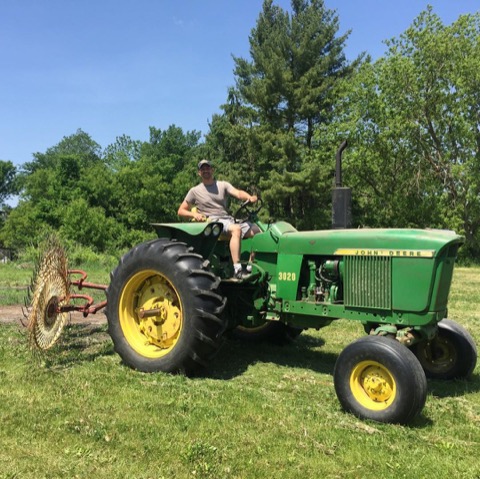
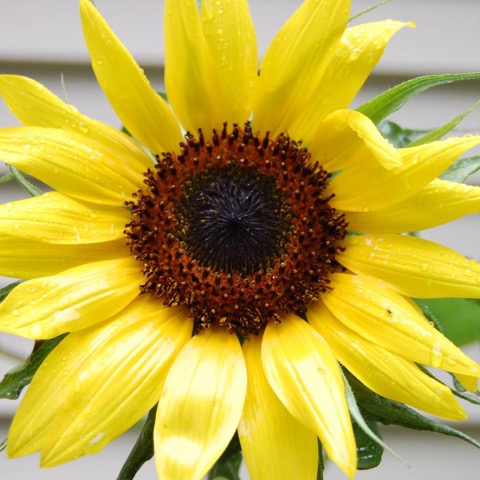

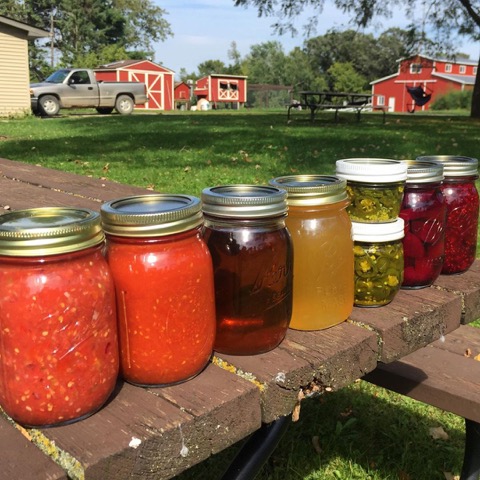
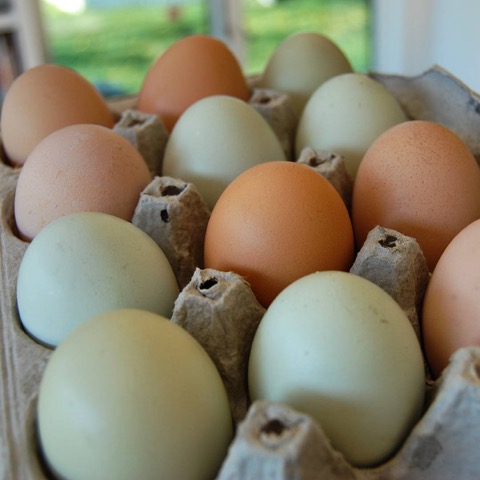

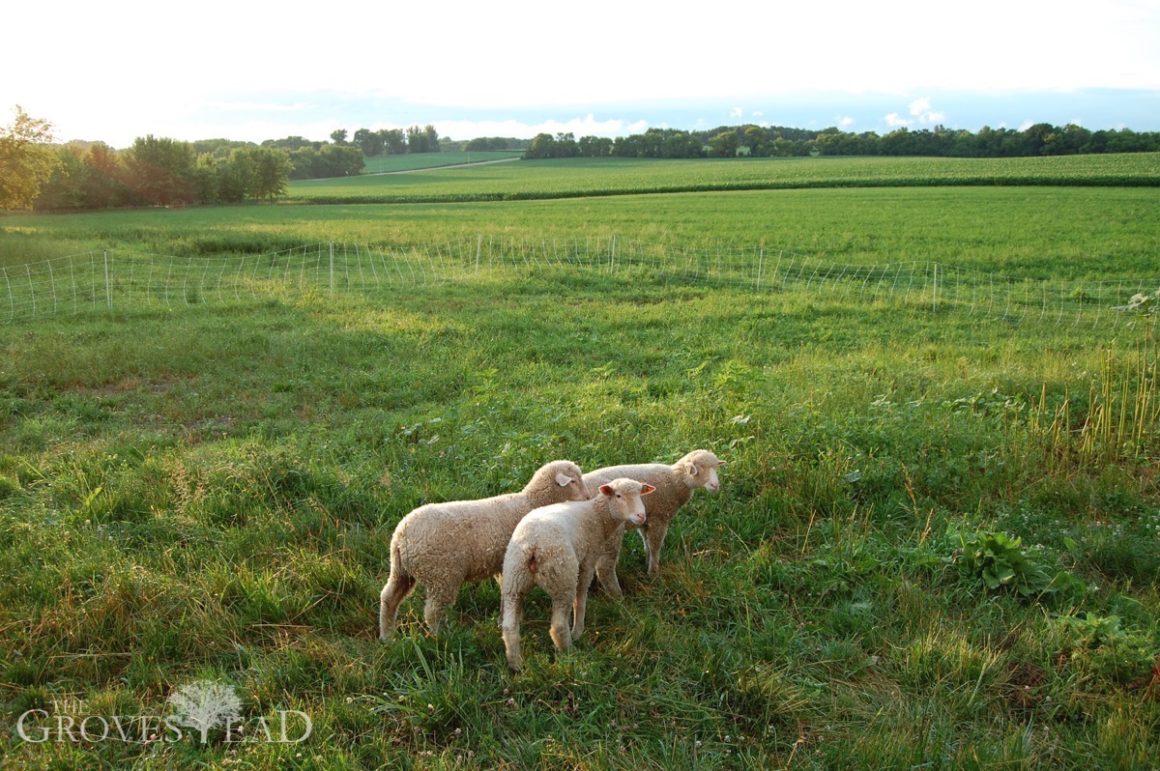
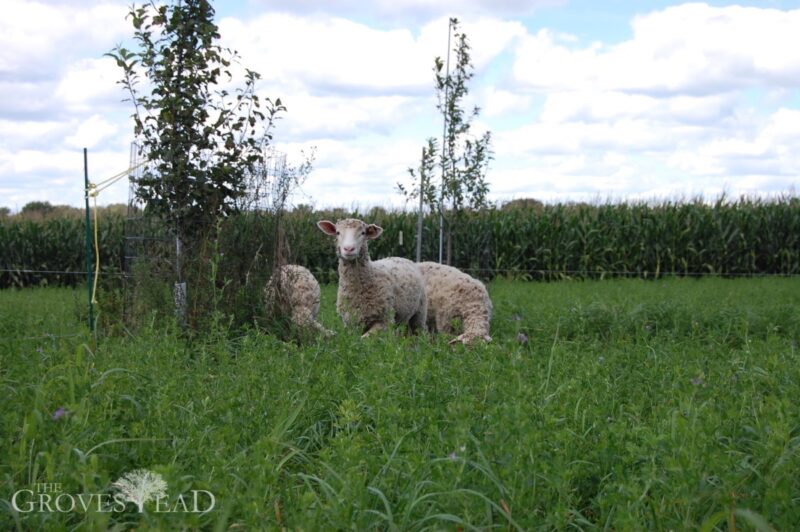
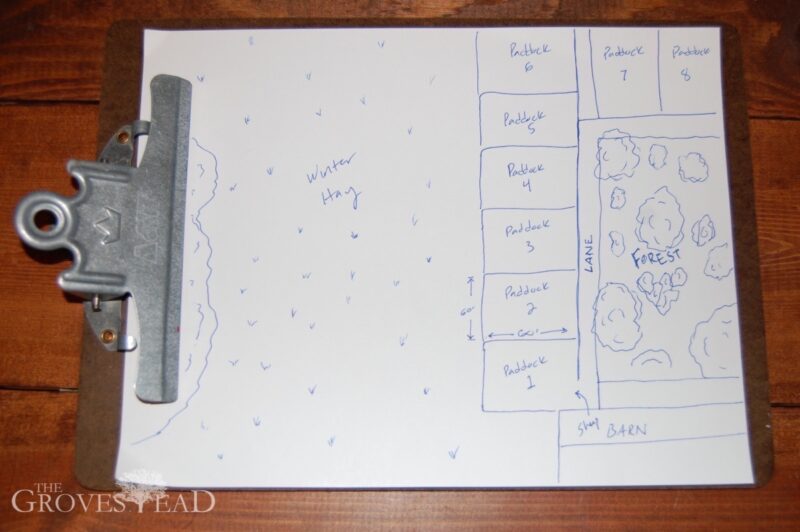
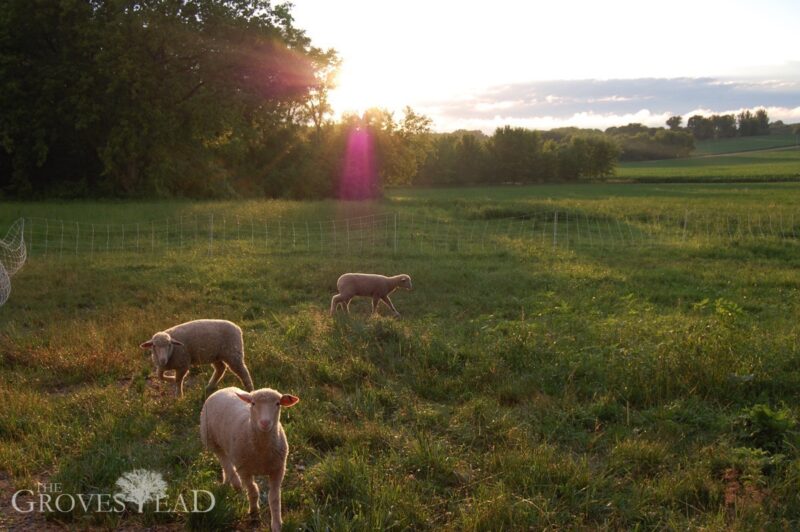
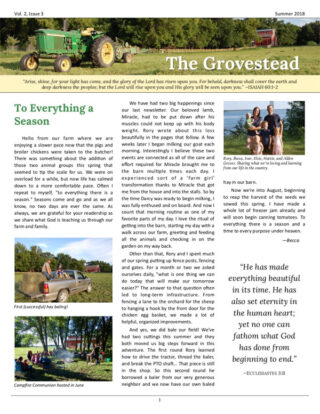


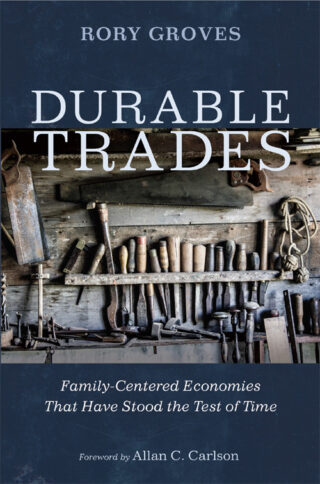
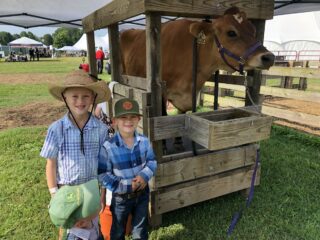
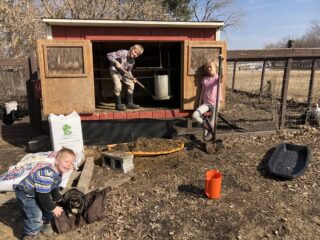
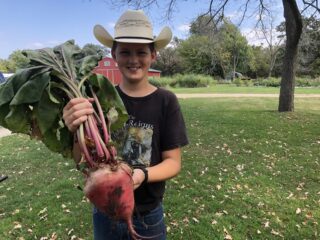
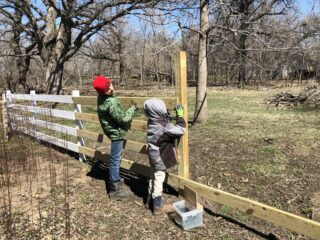
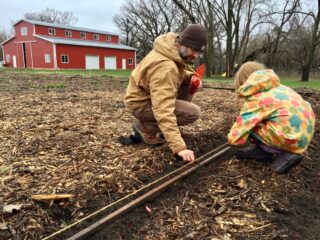
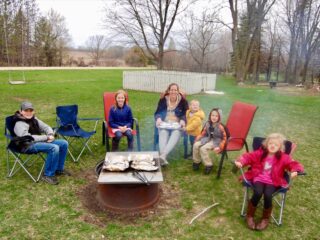
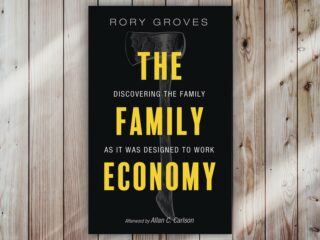
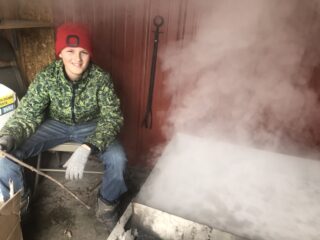
35 comments
How did it go? This is about the numbers I am looking at. Thanks for the info and insight.
Mark S
Hi Mark-
Numbers are good. Fencing was not! 🙂 Some of my braver sheep kept jumping through the electric fencing, so I ended up letting them free-graze by the end of the summer. Next season I will install better perimeter fencing and use combination of physical and electric fencing.
I reviewed the numbers with both the author of the U of M presentation and a local shepherd. As with all things farming, “it depends”. Weather, grass variety, breeds can all have an impact on actual stocking density. Have to watch the actual plot. But the numbers above are fine for a starting point.
hi! did you provide shelter? I’m on the fence about that
Thanks so much for this article. I have 2 goats, and am getting 2 young sheep on loan this Spring in order to increase the soil health of my 8 tilled acres. I was feeling a little overwhelmed by the planning process, but you did it for me!
Thank you Judith! Best of luck to you. There’s no match to actual experience. But its a sound approach overall and I will stick with it this season again (after some fencing improvements).
Nothing like animals to improve the soil health. If you really want to amp up your pasture in a short amount of time, put chickens on it, either following the livestock rotations or free ranging. They scratch and fertilize the ground better than anything.
Hi Judith! I am starting this year with three goats and four sheep and like you was thrilled to find this information here. Such a gift! My question for you (if you happen to see this five years later!) is whether you graze your sheep with your goats, and if you’ve had any trouble with parasites? Thank you!
great article! I have 6 sheep and have been trying hard to figure this out and getting a lot of conflicting , confusing information. How many sheep do you have now and are you still practicing this?
Any update on this (acknowledging the article is a couple of years old)?
I’m looking at a similar system, with daily moves, on fairly marginal land (so have used the lowest numbers you provided as my starting point).
So my numbers look like about 350 square feet per sheep with daily moves. In Aus we use DSE more usually than AU, and I’ve found data that says a wet ewe is more like 2.5 times the feed requirements of a dry sheep, so have based my paddock sizes etc on that 2.5 assumption.
Also, I’ve read you can add pasture seeds to the flock supplements – the sheep will defecate the seeds and tread them in to the pasture, meaning you get new pasture seeded at the right time. Have you tried anything like this to increase your pasture coverage without having to do a large amount of tilling?
Still doing it, though I’ve modified the paddocks a bit. For me it worked better to arrange the paddocks in rectangles than squares. Supposedly square is best but it doesn’t seem to make any difference for me. The other issue is time of year. Right now in spring/early summer the grass is growing so fast my sheep can’t keep up, so I mow down after they move on. Its a bit of a hassle but hopefully temporary.
Thats not a bad idea with the seed-spreading technique .. i’ve never heard of that.
How do you sort water? and moves?
Have seen that you’re using mesh fencing, and so presumably a solar energiser. Are you carting water each time you move, and using a small local tank with a trough on it in the enclosure?
Then from a purely practical point of view, do you lead sheep to where you want to shift them with a treat like sheep nuts or a small amount of grain or something? So have 2 nets, pre-set up the next net with an opening, and lead sheep with a treat?
Hi Michael- We use a regular bucket and hose with automatic shutoff valve. It’s just a 3-gallon bucket so not a big deal to move by hand. The electric netting is connected to a very long coax cable that reaches our barn, and charger inside.
When it comes time to move the sheep, I usually guide them into a holding area, such as the fence lane and keep them there until I have the new paddock arranged. Then let them back in. You can use corn to try to get them to follow you. That works as long as there is not tasty grass before they get to the designated paddock. Otherwise you’ll lose them and have to chase them around. Really the best way to do this is arrange the paddocks and lanes so there is nowhere else for them to go (close off all paddocks except the one you want them to enter). Then just get behind them and they will walk right out into the paddock. Hope that makes sense.
Great informations. I’m starting with sheep in my small property and its being dificult to find these numbers. I’m curious too about how things are going for you.
Things are going well here, and we’ve been able to maintain the same size pasture for 3-4 years.
How many sheep or any other ruminants do you have now?
We just restarted our herd this year with purebred Katahdins, so we’re down to just 4 breeding ewes. Should be growing soon, however!
Thanks for the helpful information. I’m looking to start a similar scale herd this year and this fits my pasture size perfectly. How did you like the Katahdins? I am looking at beginning with that breed.
Hi Rory
Firstly, just wanted to thank you for this BRILLIANT article. Your numbers are practically identical to what I had calculated through pure guess work (actually mine were a bit more generous), so it gives me a lot of confidence.
I would love to know what kind of grasses you are growing, and whether you have to reseed them annually? I tried to go for deep rooted perennials where possible, as I am trying to avoid having to reseed the pasture every year. I believe the Alfalfa and clovers are perenials and will keep growing back year and year. But the vetches and rye grass are not. As I will be getting the sheep to graze them down well before they seed, they will not be able to self seed either. So, I am wondering if there is any trick to keeping these annuals seeding, rather than having the buy new seed each year. Would appreciate your thoughts.
I am also planting suitable fodder trees (leuceanas, carobs, fruit and nuts) along the pastures, and as the trees establish in a few years, will chop and drop branches to add tree forage for the animals.
I am planning to start (I am new to this stuff) this winter, here in the Mediterranean climate (Cyprus). I have bought enough seeds for 5 varieties: white clover, red clover, alfalfa, rye grass and vetch. I will be having about 3-4 lambs running through a paddock system nearly identical to yours in size, and plan to run some 10-20 chickens through the paddocks following the lambs.
Also, I found your guidance of 9″ height of pasture to bring the lambs in and 2-3″ height to move them out also very helpful, as I really had no idea. I was thinking more like knee to waist height for the sheep, but perhaps that’s too high. I would appreciate your insights also on:
– Would the grass be too tall at knee to waist height for the sheep to manage, or can they still graze on it?
– I have heard chickens can be quite destructive….have you got experience with them? If I move them into the pasture just grazed by the sheep, will they overgraze the paddock, dig and scratch excessively, such that the pasture suffers?
I really appreciate your time and effort in helping the community.
Thanks
Sunil
Hi Sunil, thank you for the kind comment. We started out with a horse-pasture mix, which was a variety of grasses and alfalfa. I have since overseeded with red clover (white would be fine too), as the alfalfa tends to diminish over time as the grasses take over. I’ve been told that you cannot overseed alfalfa, but clover seems to do quite nicely. I do not know about the grasses you mention, if they will overwinter. We have had no problem with the the grass, just the alfalfa diminishing. As long as the grass isn’t overgrazed, it should do fine without reseeding (expanding from roots).
One note about trees; I have had a lot of damage to the trees from the sheep. Even though I have them all fenced, the sheep are there all day and night and can find week spots in the fence. Just last week they discovered the bark tastes good and started stripping bark from any of the trees they could gain access to.
One thing I would definitely recommend is the electro netting as opposed to polywire strands. I started out polywire because it was so much cheaper but the sheep constantly broke through. They never get through the netting.
To answer your specific questions:
– Waist height is too tall for sheep; they will not graze this. I had to learn this the hard way and mow down a whole field because I let it get too long. Sheep love young, tender grass. They do not like the taller grass because it is coarser.
– I currently do not run chickens after the sheep but I am considering doing it. I don’t think the chickens will do damage if they are moved regularly and allowed to range around in the paddock.
I am just getting started in my sheep adventure and this is great information. I live in Kansas and the summer sun can be brutal along with the wind. What do you use for shade in the paddocks? And how much protection from the winter cold do sheep need? I had thought to graze the sheep in our peafowl pens to help keep the grass mowed off. The pens are 12×25, and this worked well by rotating them daily. But there were problems of keeping the sheep out of the bird feed and spooking the birds! So my husband thinks they need their own space.
Thanks, Candy
Hi Candy – Our paddocks have apple trees (fenced) and border a tree line, so the sheep have some shade if they need it. I’ve also tried building mobile sheds but they kept blowing over in the wind. My experience is that the sheep don’t need all that much shade. They often will lay down in full sun in the middle of the paddock when shade is available. In the winter, sheep are extremely cold-hardy. They do need a wind break, though.
Hello!
Great article. We are wondering whether MIRG increases yield at the end of the year for winter silage? We have very limited grazing areas in Norway. Other articles say one can increase yields by 3 times, but not sure if they mean silage. We have a really long winter and very short, intensive summer w 24 hour daylight.
Thanks Christine and Valentin
Is your dog based on the amount of grass the sheep eats per day. IE 264 sf of grass per day per sheep?
I too have struggled to find grass requirements on a sf per day per sheep.
Good article!
Hey Rory! I’ve been enjoying reading about your family’s journey. I wa wondering – have you researched the use of hedgerows at all as an alternative to fencing? Just wondering as I was reading that it’s an old practice with a lot of benefits to the land and yet it seems less commonly practiced in the US. I personally am also partial to it aesthetically…but it also seems like maybe it could solve problems with animals getting through and be easier (?) to maintain? Just curious. I have no practical experience with this at all!
Hi Noelle! I just saw your comment on hedgerows and as someone who also very much loves the aesthetic of hedgerows (but lives in Vermont), I thought I’d let you know what I’ve learned. The challenge with hedgerows in the US is that they take many, many years to get big and dense enough to actually be able to keep sheep in. That being said, I’m not daunted by time and am ambitiously trying to grow a hedgerow for many years down the road. I have read that sea buckthorn is a really great sheep hedgerow, and is double/triple purpose: it is a wonderful cash crop because the seeds of the fruit are amazing in skincare, and the berries are delicious. It will take probably a decade to get the hedgerow dense enough, but I’ll enjoy it in the meantime! I found sea buckthorn plants and seeds on Strictly Medicinals. Hope this helps!
How did that 33AU per acre per day figure come about? I’m trying to use NRCS data on vegetative productivity of different types of soil on my land and their estimates alternate in units between pounds/acre/year and AUMs. Putting it all together is difficult.
It was based on some controlled experiments. I found the UMN document that goes into this and updated the link in the post. Of course, vegetative growth is always variable on many factors. 33AU is just a reference.
Hello! I’m wondering if 2.5 acres is just too small for holistic grazing practices? I am fantasizing about having a sheep/goat rental business for land regeneration in Teton Valley, Idaho. Our property is only 2.5 acres but I would be transporting them around the valley to graze peoples land…any thoughts? Ideas? Suggestions?
Stocking density is (supposedly) 10 sheep per acre. I’ve seen many more on much less than 2.5 acres, you just have to bring in hay. So no, 2.5 is not too small.
Thank you for this! We purchased our farm last year and will be rotationaly grazing the first time this year with sheep, cattle and chickens. Currently have only about 25 AUs, but you helped me figure out the math so much easier than all the stuff on the internet! Great starting point. Thanks!
Hi. Good article, your calculations are based on 4 sheep you have permanently but does it consider lambs? E.g. if you get 8 lambs in spring then your numbers triple? How this works? Probably growing lambs graze more than ewes?
Area i would allocate is approx square, so was thinking to make some permanent shelter with drinker just in the middle and then divide site into number of paddocks so that sheep gathers at the shed in the middle and then i just open gate to one paddock at the time and just go clockwise. Yes paddocks wouldn’t be square and i am bit anxious what that middle area would look like after some time?
I have 3.5acres and am considering to allocate about half for sheep so trying to make a plan. Also few years i have planted about 100 forest trees at the back of the site just to shelter land from west winds, grass grows very tall in between the trees and constant work with trimmer is waste of energy so was wondering if i could include it onto paddocks so that it gets grazed but saw in your comments that you had issues with that?
Many thanks
You can raise Shropshire sheep in orchards as they don’t care for tree bark, it’s been done in the UK for centuries.
Rory, our family moved in 2020 from Chicago to a small town outside of Purdue. We currently raise layer chickens and rabbits, and are looking at expanding next summer to multi-species rotational grazing, adding a new species each year for the next several years until we have a milk cow, a few sheep, a couple pigs, and various birds. We have been involved with Illinois Christian Home Educators for 20+ years and are so excited you are coming to the 2024 conference. My “kids” (all 18+ now) and I hope to have the chance to chat with you.